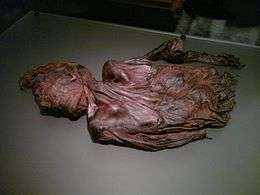Clonycavan Man


Clonycavan Man is the name given to a well-preserved Iron Age bog body found in Clonycavan, Ballivor, County Meath, Ireland in March 2003.
Only his torso and upper abdomen are preserved. He was found in a modern peat harvesting machine, which was possibly responsible for the severing of his lower body.[1] He had a squashed nose and crooked teeth. Pores are visible on the nose, and he had a thin beard.
Clonycavan Man has formed part of an exhibit in the National Museum of Ireland in Dublin - and featured in the exhibition "Kingship and Sacrifice", 2006-2007.
It has been suggested that Clonycavan Man had once been a king and was ritually sacrificed.[2]
Death

Clonycavan Man is believed to have been murdered, based on an examination of the evidence found on his body by the Garda Technical Bureau (Irish Police Forensic Division). His skull was split open by a sharp implement. There is a deep wound on the top of his head, and parts of his brain have been found in this wound. There is also a large laceration across the bridge of his nose leading under his right eye. This is believed to be the blow that killed him. [2] Both injuries seem to have been caused by the same sharp implement, most likely an axe. His death is believed to be that of a ritual sacrifice.[2] Radiocarbon dating has placed his death to between 392 BCE and 201 BCE,[3] during the Iron Age of western Europe, making his remains around 2,300 years old.
Scientific study of his hair has shed light on Clonycavan Man's diet leading up to his death. His diet was rich in vegetables and proteins, which indicates that he may have been killed during the warmer summer months of the year.[1][2] Clonycavan Man was also fairly young at the time of his death; he is believed to have been in his early twenties.[1] Such sacrifices were performed due to the possible belief that the current king of a certain region was responsible for poor harvests or other attributes, and a sacrifice such as this would please the goddess of fertility.[2] A hill that was likely used for kingship ceremonies was near the bog where Clonycavan Man was found; it may have been where he was initiated as a king.[2]
Hair
The most distinguishing feature of the man was his hairstyle, which was raised upon his head with the help of a "hair gel"[3] of plant oil and pine resin, imported from south-western France or Northern Spain.[4][2] Remnants of a hair tie was also found on the corpse.[2] This may attest to trade between Ireland and southern Europe in the fourth and third centuries BCE, before Roman influence was brought to bear on the Celts of Iberia. This could also suggest that he was wealthy, as few others would have been able to buy imported cosmetics.[5] The hairstyle was possibly a way to make the man appear taller, as examination of his remains suggests that he was only five feet two inches tall (157,48 cm).[2]
See also
References
Coordinates: 53°31′29″N 7°0′26″W / 53.52472°N 7.00722°W[6]
- 1 2 3 "Iron Age 'bog bodies' unveiled". BBC News. 7 January 2006. Retrieved 14 April 2015.
- 1 2 3 4 5 6 7 8 9 "Ghosts of Murdered Kings - Transcript". NOVA. 29 January 2014. Retrieved 14 April 2015.
- 1 2 "Iron Age 'Bog Man' Used Imported Hair Gel". National Geographic. January 17, 2006. Retrieved April 14, 2015.
- ↑ "The Perfect Corpse" Transcript". PBS. February 7, 2006. Retrieved April 14, 2015.
- ↑ "Tales From the Bog". National Geographic. September 2007. Retrieved April 14, 2015.
- ↑ "www.excavations.ie 2003 County Meath 10186".